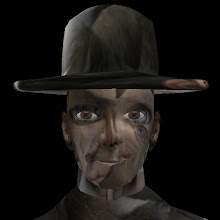Traditionally, art and design students have learned things through making stuff in a big, mucky studio. Over the last 10 years, the studios have gone quiet. Funnily enough, the computer rooms have got really busy. There may be a link. We are moving to a new art school building in a year and a bit. We plan to revive the studio culture in the new space by spreading the IT equipment, and all of the other workshop kit across the big studio space. We will have flexible, reconfigurable spaces, with movable walls and wireless and fast network sockets everywhere. We will implement in this new environment 'work spaces' or possibly 'areas of activity'. Witnessing how our students are engaging with Second Life, it strikes me that we have a really good model for the 'workspace' concept in place. I wrote this article for the Second Life Community Convention publication last year:
"Second Life is many different things to many different people. For me, it is a studio and a workshop. It is that place where I invent stuff. Stuff that is a product of my overactive imagination.
My imagination has been overactive for a long time. I am fortunate enough to have spent most of my adult life swimming in a sea of learning. This sea is a particularly adventurous take on the U.K. art-education system. Our version of this educational model places the individual at the centre of learning and asks them to look outwards and inwards to unearth their own personal passions. They do this in a variety of conventional and unconventional ways, but the most significant method for generating and cementing knowledge is the creation of artwork. There is not much in the way of delivery of set content. Knowledge is generated through an ongoing process of dialogue and production. The users power the learning. It is Learning 2.0, and it’s been like that ever since I’ve known it.
Key to this process is the studio, the environment that enables such learning to happen. The studio is a research area, a social space, a place to view work and a space to exchange ideas with peers and experts. It hosts parties and relationships develop there. Most of all, it is a workshop where we learn through doing, through making. When the studio environment is just right, learning explodes throughout, and amazing things are created.
Second Life has provided us with a new studio, and this new environment is just right. The media that we manipulate in this space is different, but the mental processes are familiar. This new type of media enables a more rapid manifestation of ideas, and so the mental processes are accelerated. That is why I am so in love with Second Life. It is hyper-learning. It enables me to mainline my creativity.
Second Life provides an opportunity for many others to benefit from such accelerated learning. I wonder what would happen if other discipline area had their own studios, and approached learning in the same way that we do. Perhaps it wouldn’t work, but Second Life could give us an opportunity to try it out without too much risk. I can’t see how it would do any great harm. I know that many other educators are using Second Life to enable learning, and there are many different educational models that are being explored. It is a very exciting time, and I relish each new way that this world can be used to enhance learning.
Another hugely significant part of our particular educational model is the emphasis we place on the professional practice of staff. We are all practitioners, and our practice informs our teaching not just because it keeps our personal knowledge up to date, but also because it forces us to adopt the role of a learner. Our job is not to feed our students on a diet of ‘what you should know’ or to make them to do things the ‘proper way’ (not that there is anything wrong with that. It’s just not our particular focus). We seek to inspire our students by sharing our love of learning and our methods for acquiring knowledge. That is why I do what I do in Second Life. I do it for the sheer joy of learning."
Re-reading this reminds me of something else that might be important, the Master-Apprentice model. This is something else that has gone out of the window a bit over recent years, as staff have had to sacrifice research and professional practice to cope with increased student numbers. I want to re-establish this model across our School of Art and, again, this is happening in Second Life. I'm an artist in SL, and I work alongside my students, with some of my greatness (ironic) hopefully rubbing off on them, with them learning by seeing etc. This might be too much for Habitat. Maybe I'll save it for another project.
Saturday, 26 January 2008
Subscribe to:
Post Comments (Atom)

No comments:
Post a Comment